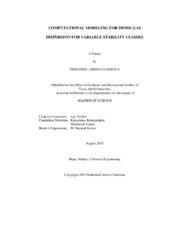| dc.description.abstract | The spill of many chemicals such as Liquefied Natural Gas (LNG) on land or water results in its rapid vaporization and the formation of a dense cloud. The performance of a risk assessment for the spill of flammable chemicals requires the determination of the maximum downwind distance where the Lower Flammability limit (LFL) is reached. The modeling of such spills is usually divided in two parts: source term and atmospheric dispersion. The source term describes the cryogenic liquid release rate and conditions. The atmospheric dispersion describes the increasing cloud propagation downwind after the release and the extent of the LFL distance until a steady state is reached. The focus of this work is the preparation of a model for the atmospheric dispersion after the spill of LNG on land using Computational Fluid Dynamics (CFD).
CFD is a model based on solving Navier Stokes equations (conservation equations of mass, momentum and energy) in a specific 3D domain.
The use of CFD as a tool for the prediction of dense clouds dispersion and LFL distance calculation by industry and research institutions is increasing significantly because it provides an adequate description of the phenomena of dense gas flow, dispersion and it can handle complex geometries.
The objective of this research project is to prepare a CFD scheme for vapor cloud dispersion resulting from accidental spill of cryogenic liquid on land using CFD (FLUENT) for medium scale LNG/LN2 spill experiments to be performed at the Ras Laffan Emergency and Safety College (RLESC). The validation of the CFD (FLUENT) model is performed using dense gas dispersion data from literature (Prairie Grass).
There is a lack of dense gas dispersion modeling for the unstable class because of the complexity of velocity, temperature and turbulence equations for this class. This model should be able to predict the dense cloud vapors dispersion for different stability classes (neutral, stable and unstable).
A crucial parameter in the modelling of the dispersion of the dense gas is the choice of the turbulence model. There is currently no agreement on which model performs better for this application. This work involves a sensitivity analysis of the dispersion results to determine the choice of the turbulence model. The focus will be on three turbulence models which are the most used for this application: standard k – ε , realizable k – ε and Reynolds Stress Model RSM.
The results from the modeling of three sets of Prairie Grass experiments suggest a good agreement between the simulation and experimental results only for the centerline concentration and for the stable and neutral classes. For the unstable class, there is a considerable overprediction of the centerline concentration. This work includes an attempt to compare model predictions with experimental concentrations at each location. Only centerline concentrations or highest concentrations were considered in previous works. Form this comparison; all three models were unable to predict the concentration measurements accurately.
The RSM model yields relatively the best results for atmospheric an dispersion modelling compared to the standard k-ε and realizable k-ε models. As a result, it is advised to use this model for this application. | en |


